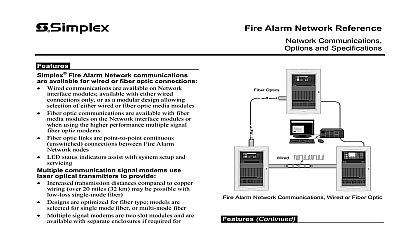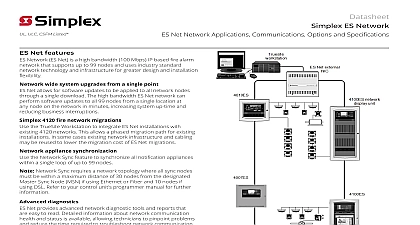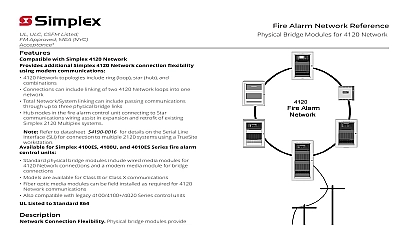Simplex Fire Alarm Network Reference; Network Communications, Options and Specifications

File Preview
Click below to download for free
Click below to download for free
File Data
| Name | simplex-fire-alarm-network-reference-network-communications-options-and-specifications-4891325706.pdf |
|---|---|
| Type | |
| Size | 2.78 MB |
| Downloads |
Text Preview
Simplex 4120 Fire Alarm Network Network Applications Communications Options and Specifications control units For other compatible fire alarm control units cabinets are available Please refer to datasheet S4100 0049 details network communications among system fire alarm control provide Support for up to 99 nodes per network loop to provide network voice broadcasts and centralized command center Multiple network loops for campus and other high panel quantity Network wide initiation of alarm silence acknowledge and reset and of status and details of system points and point lists Distributed system operation to ensure excellent survivability during a fault condition Network nodes remaining connected regroup and continue communicating Flexible network annunciator options such as TrueSite workstations display units NDU and NDUs with voice command center Use of InfoAlarm command center equipped nodes to provide network information display capability Network level command and control provides manual point control for or disable enable as well as gathering specific point detail 4120 fire alarm network communications are available wired or fiber optic connections Wired communications are available on network interface cards NICs with either wired connections only or as a modular design selection of either wired or fiber optic media modules Fiber optic communications are available with fiber media modules the NIC or when using the higher performance multiple signal fiber modems Fiber optic links are point to point continuous unswitched between fire alarm network nodes LED status indicators assist with system setup and servicing network interface cards details Class B or Class X network communications using wired or fiber optic modules selectable separately to match media requirements media module details Provides isolated earth detection Compatible with Simplex isolated loop and over voltage protectors Electrical characteristics are similar to RS 485 fiber optic media module details Fiber optic links provide immunity to electrical transients short circuits ground conditions Laser based fiber optic media modules use one multi mode or one fiber to communicate includes a single type SC connector with 62.5 125 or 50 125 multi mode fiber or single mode fiber Onboard diagnostics provide information regarding the performance health of the fiber link signal fiber modem details Laser based half duplex communications for a variety of signal over a single fiber connection Available for single mode or multi mode fiber Increased transmission distances compared to copper wiring over 20 32 km may be possible with low loss single mode fiber Multiple signal modems can be mounted within the cabinet for 4100 to individual product datasheets for specific product listing details 1 alarm network wired or fiber optic bridge modules connect multiple network loops and star topology connections Physical bridge modules connect to network communications using or fiber optic media and interconnect using modem media Refer to datasheet S4100 0057 for details TCP IP physical bridge modules are similar but provide local area LAN compatible interconnections Refer to datasheet for details diagnostics include Attendance and polling error logging LED status indications on interface board Synchronized time and date allowing precise data logging information listings for 4120 network control units and accessories UL 864 Fire Detection and Control UOJZ Smoke Control Service Releasing Device Service SYZV UL 1076 Proprietary Alarm Units Burglar APOU UL 2017 Process Management Equipment QVAX Emergency Alarm Control Units FSZI UL 1730 Smoke Detector Monitor UULH UL 2572 Mass Notification Systems PGWM CAN ULC S527 Control Units for Fire Alarm Systems UOJZ7 Releasing Service SYZV7 ULC ORD C1076 Proprietary Burglar Alarm Units and Systems APOU7 ULC ORD C100 Smoke Control System Equipment UUKL7 Rev 12 11 2020 Network Applications Communications Options and Specifications 4120 network operation fire alarm networks communicate information among distributed Simplex fire alarm panels Systems may be composed of similar capability sharing information or specific nodes may be added to perform dedicated network functions Illustrations on the following pages provide a of a variety of fire alarm Network applications non Simplex panels a Network System Integrator can be used to connect equipment to the network using optically isolated inputs and relay outputs panel with direct communications into the network is defined as a node Each node can be a large or small fire alarm control unit TrueSite TrueSite Incident Commander or Network System Integrator process information is sequentially transmitted from one node to another At each node the network message is captured and either retransmitted received or modified before retransmission to provide the network with a status update The ability of the message to circulate through the will define the network status and allow the nodes to respond accordingly a node goes off line or if the connection between nodes either shorts opens or has any other form of communication problem the nodes will that section of wiring Nodes that cannot retransmit onto the next node of the network will transmit back to the previous node to maintain and to notify the network of the node status In the event of multiple wiring problems the remaining nodes will effectively establish new smaller that will maintain communications among the active nodes options 2 shows a multiple node network interconnected with a variety of communications means for reference Wired communications are compatible with a variety of new and retrofit wiring Duplex fiber optic media card communications use a single fiber available for single mode or multi mode fiber and are dedicated to Network Multiple communication modems use a single fiber available for single mode or multi mode fiber and can carry multiple communications signals as network communications and network audio broadcasts TCP IP physical bridge modem communications are also available refer to Additional 4120 network reference for more information Refer to NFPA 70 NEC or other applicable codes for shielded wiring and protective device requirements when wiring enters and leaves a 2 network communications options reference For additional details on network audio requirements refer to datasheet S4100 0034 2 Rev 12 11 2020 Network Applications Communications Options and Specifications loop network operation using a TrueSite Workstation or Incident Commander extensive network expansion or interconnection of existing separate networks is required up to seven 4120 network loops may be interfaced the TrueSite Workstation Up to two network loops can be interfaced using the Incident Commander network loop is connected to its own network interface card allowing the workstation to appear as a node in each individual loop With the as a network loop interface information from all nodes on the network up to seven loops can be annunciated on a central workstation a multi loop network connection the TrueSite Workstation and Incident Commander are member nodes of each network loop with up to 98 nodes per loop This allows up to 686 total nodes and the TrueSite Workstation Server 687 in total to be interconnected 4120 and ES Net networks TrueSite Workstation node can attach to as many as seven network loops up to one ES Net loop and six additional 4120 loops or up to seven 4120 An Incident Commander node can attach to as many as two network loops up to one ES Net loop and one additional 4120 loop or up to two loops operation features survivability Individual network loops operate independently In the event of loss of one or more loops remaining loops continue to operate independence loops can be added without impacting existing loops with phased in system expansion Each loop can be installed as a stand alone network allowing local node programming to evolve as required When construction or renovation reaches completion loops can be consolidated for


